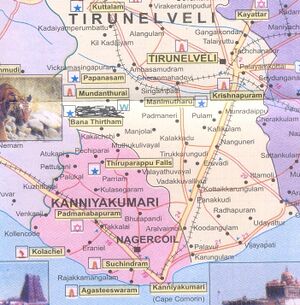Papanasam

Papanasam (पापनाशम) is a pilgrim mentioned in ancient Indian literature located in Tirunelveli District, Tamil Nadu.[1].
Location
It is dedicated to Shiva. It is located 60 km from Tirunelveli.
Variants
- Papanasham (पापनाशम)
History
Papanasanathar temple
Papanasanathar Temple is in Papanasam village in Tirunelveli district in the South Indian state of Tamil Nadu. It is dedicated to Shiva. It is located 60 km from Tirunelveli. Constructed in the Dravidian architecture, the temple has three precincts. Shiva is worshipped as Papanasanathar and his consort Parvathi as Ulagammai.
A granite wall surrounds the temple, enclosing all its shrines. The temple has a seven-tiered gateway tower. The temple was originally built by Chandrakula Pandya, with further additions by the Vijayanagar and Nayak kings during the 16th century. The temple has artistic sculptures representative of Nayak art. Legend and religious significance
Legend
As per legend, during the divine wedding of Shiva and Parvathi, there was heavy crowd at Kailash. Sage Agasthya could not get a vision of the event and was praying to Shiva at this place and pleased by his devotion, Shiva appeared to him and his wife Lopamundra in Kalyana posture. The falls nearby the temple is thus called Agasthiyar Falls.[2]
As per another legend, sage Urosamar floated a set of flowers in Tamiraparani River and the first flower reached the shore at this place. The sage established a temple for Papanasanathar and worshipped the deity here.[3]
The lingam, the iconic form of Shiva in the temple is believed to an aspect of Surya, one of the planetary deities. The temple forms a series of Navagraha temples in the banks of Tamiraparani river where each of the nine planetary deities are considered to reside in one temples. The temples are classified as Nava Kailasam and the presiding deity of all the nine temples is Kailasanathar. The temple is associated with the planet Surya (Sun) and considered first in the series of the nine temples.[4]
The lingam is believed to have appeared from kala tree and is called as Mukkala Nathar.
There are images of Somaskanda, Rishabaroodar and Agastya close to the image with unique sculptural representation.[5]
As per another legend, the king of celestial deities, Indra slayed a demon Dwastha, the son of Sukracharya (the Guru of Asuras) as he was performing a penance to seek superior powers against the Devas. Indra incurred Brahmatti Dosha, a sin attained for slaying the Brahmin. He roamed around a lot of places for doing penance and finally on the advise of Brihaspathi, he landed at Papanasam. Since his sin (Papam locally) was expiated in this place, it came to be known as Papanasam. This Legend is to Elucidate the real Importance of Good Brahmin Communities and also the Power of Temple. [6]
External links
References
- ↑ https://www.esamskriti.com/e/History/Great-Indian-Leaders/Lives-of-Indian-Saints-11.aspx
- ↑ Knapp, Stephen (2009). Spiritual India Handbook. Jaico Publishing House. p. 342. ISBN 9788184950243.
- ↑ "Sri Papansanathar temple". Dinamalar. 2014.
- ↑ "Sri Papansanathar temple". Dinamalar. 2014.
- ↑ V., Meena. Temples in South India. Kanniyakumari: Harikumar Arts. pp. 8–9.
- ↑ "Sri Papansanathar temple". Dinamalar. 2014.

